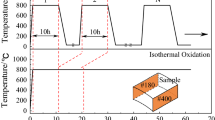Abstract
TP310S (25wt.% Cr–20% Ni–Fe) sheet and foil specimens of 0.11–1.20 mm thick were oxidized at 700–1000°C for 500 hr and 1050°C for 242 hr in a 3vol.%O2–9%CO2–16%H20–N2 gas atmosphere. Except for specimen edges and corners, significant breakaway oxidation resulted for 0.11 mm thick specimens heated at 1000 and 1050°C. For specimens of more than 0.22 mm thick, protection by a Cr2O3 scale occurred and breakaway oxidation did not take place. Above 1000°C, the oxidation resistance of thin-foil specimens 0.11 mm thick was appreciably worse than the “thick” sheet specimens. Electron-probe microanalysis (EPMA) depth-profile measurements of Cr have demonstrated that the breakaway oxidation which occurred on the 0.11 mm-thick specimens was initiated upon complete removal and virtually zero content of soluble Cr in the underlying base metal. For the TP310S steel foil specimens, protection by a Cr2O3 scale was effective until the concentration of soluble Cr in the base metal decreased to zero percent. The mechanism of the breakaway oxidation observed for the TP310S steel foils was interpreted as “chemical failure” of the Cr2O3 scale, rather than the well-known mechanical failure of protective Cr2O3 scales.
Similar content being viewed by others
REFERENCES
B. A. Pint, R. Peraldi, P. F. Tortorelli, Corrosion 2003, paper no. 3499, NACE, Houston TX, presented at the NACE Corrosion 2003, San Diego.
P. Kofstad, High Temperature Oxidation (Elsevier Applied Science, 1988) p. 383.
G. C. Wood, Corrosion Science 2, 173 (1961).
G. Y. Lai, High-Temperature Corrosion of Engineering Alloys (ASM International, 1990) p. 23.
R. H. Kane, in Process Industries Corrosion, B. J. Moniz, and W. I. Pollock, eds. (Houston TX, NACE, 1986) p. 51.
M. G. Fontana, and N. D. Greene, Corrosion Engineering (McGraw Hill Book Company, 1967) p. 369.
L. A. Morris, Metals Engineering Quarterly, American Society of Metals 8, 30 (1968).
G. C. Wood, Corrosion Science 2, 255 (1962).
Ref. 2, p. 259.
G. C. Wood, T. Hodgkiess, and D. P. Whittle, Corrosion Science 6, 129 (1966).
D. Caplan, and G. I. Sproule, Oxidation of Metals 9, 459 (1975).
K. Lillerud, and P. Kofstad, Journal of the Eletrochemical Society 127, 2397 and 2410 (1980).
B. D. Bastow, D. P. Whittle, and G. C. Wood, Oxidation of Metals 12, 413 (1978).
H. Fujikawa, Y. Shida, K. Fujino, and J. Murayama, Corrosion Engineering 31, 166 (1982).
G. C. Wood, and D. P. Whittle, Corrosion Science 7, 763 (1967).
W. W. Smeltzer, Acta Metallurgica 8, 268 (1960).
Author information
Authors and Affiliations
Rights and permissions
About this article
Cite this article
Otsuka, N., Nishiyama, Y. & Kudo, T. Breakaway Oxidation of TP310S Stainless-Steel Foil Initiated by Cr Depletion of the Entire Specimen in a Simulated Flue-Gas Atmosphere. Oxidation of Metals 62, 121–139 (2004). https://doi.org/10.1023/B:OXID.0000038789.20019.a9
Issue Date:
DOI: https://doi.org/10.1023/B:OXID.0000038789.20019.a9



